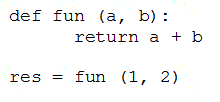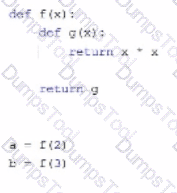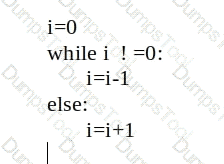What is the expected behavior of the following code?
x - 3 % 1
y -1 if x > else 0
print (y)
How many elements will the list2 list contain after execution of the following snippet?
list1 = [False for i in range (1, 10) ]
list2 = list1 [-1:1:-1]
A Python module named pymod, py contains a function named pyfun ( ).
Which of the following snippets will let you invoke the function? (Select two answers)
Which of the following literals reflect the value given as 34.23? (select two answers)
You need data which can act as a simple telephone directory. You can obtain it with the following clauses (choose two relevant variants; assume that no other items have been created before)
Select the valid fun () invocations:
(select two answers)
def fun (a, b=0):
return a*b
What is true about Object-Oriented Programming in Python? (Select two answers)
A method for passing the arguments used by the following snippet is called:

What is the expected output of the following code if there is no file named non existing_file inside the working directory?

A property that stores information about a given class's super-classes is named:
Python's built-in function named open () tries to open a file and returns:
Assuming that the following code has been executed successfully, select the expressions which evaluate to true.
(Select two answers.)

Which of the following words can be used as a variable name? (Select two valid names)
Assuming that String is six or more letters long, the following slice
String[1:-2]
is shorter than the original string by:
How many elements will the list1 list contain after execution of the following snippet?
What is true about Object-Oriented Programming in Python? (Select two answers)
You are going to read just one character from a stream called s. Which statement would you use?
What will be the value of the i variable when the while e loop finishes its execution?
